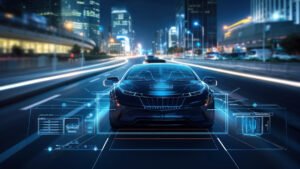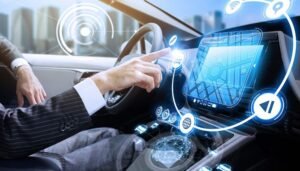Artificial intelligence (AI) is transforming the automotive industry, with AI powering many aspects of modern vehicles. From autonomous driving to predictive maintenance, artificial intelligence technology is changing the way cars are planned, built, and driven in many ways. As AI continues to develop, it will have a huge impact on future transportation, making cars smarter, safer, and more efficient.
1. Self-Driving Cars
Autonomous driving is one of the most important applications of artificial intelligence in the automotive industry. Self-driving cars use artificial intelligence algorithms to process large amounts of data from sensors, cameras, and radar, allowing them to make real-time decisions on the go. Artificial intelligence enables cars to understand their surroundings, find obstacles, and navigate complex traffic situations without human assistance.
AI-powered systems can find and understand traffic signs, people walking, and other cars, making the job of self-driving cars safer. Companies like Tesla, Waymo, and others are leading the way in creating self-driving cars controlled by artificial intelligence. These companies are pushing the boundaries of autonomous vehicles. While fully self-driving vehicles are still being tested, artificial intelligence is making it possible for cars to drive themselves with little or no human assistance.
2. High-tech systems to support drivers
Artificial intelligence is already making an impact on cars through advanced driver assistance systems (ADAS), even though most people will not be able to drive themselves in a few years. ADAS uses AI to keep the car in its lane, with adaptive cruise control, autonomous emergency braking, and parking features. These systems use camera and sensor data transmitted in real-time to help drivers avoid collisions and make driving safer and easier.
ADAS, powered by artificial intelligence, is designed to reduce human error, a leading cause of accidents. For example, AI can recognize when a car has strayed from its lane and warn the driver or guide the car back in the right direction. Similarly, adaptive cruise control uses artificial intelligence to automatically adjust your speed based on traffic conditions, keeping a safe distance between your car and other cars on the road.
3. Artificial Intelligence and Planned Maintenance
Artificial intelligence not only makes driving better, it also keeps cars in good condition. AI-powered predictive maintenance monitors the health of your car in real-time and predicts when repairs or parts need to be replaced. AI can spot early signs of wear and tear on a car by studying data from various sensors in the car. This allows vehicle owners to fix problems before they become expensive or break.
Depending on how the car is being used, AI can tell when the battery is likely to die or when the brakes need replacing. Taking this proactive approach to maintenance can extend the life of your cars, reduce downtime, and ensure they are always in good condition.
4. Use AI to Design and Build Cars
AI is also changing the way cars are planned and built. When designing a car, AI-powered software can model different design ideas and see how they work in different situations. Experts can improve a car’s aerodynamics, fuel economy, and safety features before it’s even built. Additionally, AI can understand what people want and how the market is changing to help automakers build cars that meet people’s needs and desires.
In industrial processes, robots with artificial intelligence are very important on the assembly line. These robots can perform precise, repetitive work with few errors, speeding up production and reducing costs. Artificial intelligence is also used for quality control. It can detect defects in parts or components as they are being manufactured, ensuring that only high-quality cars make it to market.
6. Artificial Intelligence and Car Infotainment Systems
Modern cars are becoming increasingly connected, and artificial intelligence is enhancing in-car infotainment systems to make driving more personal. AI-powered voice assistants like Amazon Alexa, Google Assistant, and Apple’s Siri are being built into infotainment systems, allowing drivers to use their voice to interact with different parts of the car.
AI can also learn driver preferences over time, such as their favorite music, climate settings, and driving routes, and then automatically change these settings. This level of customization makes driving more fun and easier and also allows drivers to focus on the road with fewer distractions.
7. Application of AI in Smart Cities and Traffic Management
Artificial intelligence is not just changing individual cars, but entire transportation systems. To improve urban traffic flow, AI-based traffic management tools are being developed. AI can predict traffic congestion and change traffic light timing by looking at real-time data from cameras, sensors, and connected vehicles to reduce congestion and improve overall traffic conditions.
AI can also help optimize routes by giving drivers real-time information about traffic conditions and offering different routes to avoid delays. As cities become smarter, artificial intelligence will become a key part of connecting cars to intelligent transportation systems. This will improve urban mobility and reduce carbon emissions.
8. Artificial Intelligence and Electric Vehicles
Another key area where AI is playing a role is the rise of electric vehicles (EVs). Artificial intelligence is being used to make electric vehicles drive better overall, improve battery management systems, and find optimal charging patterns. For example, AI could find the best way to use battery power by observing how people drive and the weather, helping electric cars travel further.
Artificial intelligence is also being used to create self-driving charging stations, allowing electric vehicles to find and plug in without human assistance. This could revolutionize the way we think about refueling and make owning an electric car more convenient.
Conclusion
Artificial intelligence is changing the way cars are planned, built, maintained, and driven. This is the future of cars. Artificial intelligence (AI) is changing the automotive and transportation industries as we know them, from self-driving cars to intelligent traffic control. As cars continue to evolve, artificial intelligence will continue to be a key component in making them smarter, safer, and more fuel-efficient. This will open the door to a new era of transportation.
FAQs
1. What role does artificial intelligence play in autonomous vehicles?
Self-driving cars can use data from sensors, cameras, and radars because artificial intelligence is at the heart of their systems. It allows the car to decide in real time how fast, in which direction to drive, and how to avoid obstacles. This makes driving safer and more efficient without the need for human assistance.
2. How does AI make ADAS safer?
Artificial intelligence is used in advanced driver assistance systems (ADAS) to help drivers stay in their lane, adjust cruise control, and automatically park in emergency situations. By helping people make decisions in real-time, these systems help reduce human error, prevent collisions, and make driving easier.
3. What is predictive maintenance? How can artificial intelligence help?
Predictive maintenance uses artificial intelligence to monitor a car’s health and predict when repairs or replacement parts may be needed. Artificial intelligence can spot early signs of wear and tear on a car by looking at real-time data from sensors. This helps prevent vehicle breakdowns and reduce maintenance costs.
4. What impact does artificial intelligence have on car entertainment systems?
Artificial intelligence improves in-car entertainment by controlling voice assistants and understanding users’ preferences, such as their favorite songs or navigation routes. This allows you to control certain car functions without using your hands, making driving more enjoyable and less distracting.
5. What role does AI play in traffic management?
Artificial intelligence is used in smart traffic control systems to improve traffic flow by looking at real-time data from connected vehicles and infrastructure. It changes the timing of traffic lights, provides alternative routes, and relieves traffic pressure, making urban transportation more efficient.



